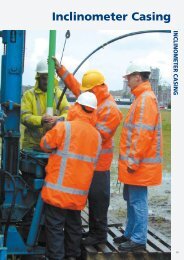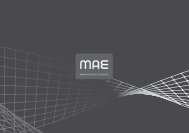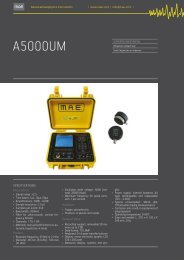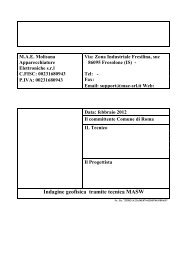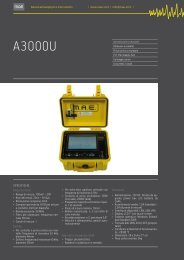Untitled
Untitled
Untitled
Create successful ePaper yourself
Turn your PDF publications into a flip-book with our unique Google optimized e-Paper software.
› Mae 11<br />
I-SONIC<br />
SUPPORTED INVESTIGATION<br />
Ultrasonic contact test<br />
Digital instrumentation for ultrasonic<br />
tests through transparency, it can<br />
be used for testing walls, trusses,<br />
partition walls, specimen, laboratory<br />
samples, and other types of concrete<br />
structures or stony materials.<br />
The extremely compact sizes render<br />
I-SONIC suitable for particularly burdensome<br />
uses, where utmost accuracy<br />
in the measurement is required,<br />
together with reliability, sturdiness<br />
and compact sizes. Thanks to the<br />
presence of a large graphic display,<br />
the visualization and interpretation<br />
of the data acquired is easy and immediate.<br />
Each single wave emitted<br />
by the internal generator is visualized<br />
in full and it is also possible to<br />
modify the visualization parameters<br />
to further facilitate the reading of<br />
the crossing speed. The data is saved<br />
on a removable S.D. memory.<br />
The ultrasonic test through contact<br />
is a standardized system in the diagnostics<br />
sector of concrete structures.<br />
From the analysis of the compression<br />
waves P in the material, it is possible<br />
to obtain the transit time (airborne<br />
time T.O.F.), of the ultrasonic waves<br />
in the material and the transmission<br />
speed of the same waves inside the<br />
material tested. The use of this method<br />
at high frequencies is particularly<br />
suitable for compact materials, as<br />
hardened concrete, and on structural<br />
elements of reduced sizes, such as<br />
beams, pillars, etc…<br />
This series of instruments allows to<br />
assess the mechanical characteristics<br />
of the materials, evaluate the<br />
degree of homogeneity and possible<br />
presence of holes, gaps, defects or<br />
building anomalies of the element.<br />
SPECIFICATIONS<br />
Acquisition:<br />
• Signal range: ±2.5<br />
• Time bases: 1μs<br />
• Amplifications: 30dB – 62dB<br />
• Sample resolution: 12 bit<br />
• Samples per event: 320<br />
• Band width: 200kHz<br />
• Filter for ultra-sounds: central frequency<br />
50 kHz<br />
• Channels: 1 TX, 1 RX<br />
• Methods: manual (with button) or<br />
automatic (repetitive in time)<br />
Probes:<br />
• Resonant frequency: 53 kHz<br />
• Diameter: 48mm<br />
• Excitation peak voltage: 500V (normal),<br />
2000V (high)<br />
• Maximum frequency for pulse emission:<br />
1 per second<br />
General data:<br />
• Keyboard: 6 charge-transfer buttons<br />
• Display: mono-chromatic graphic<br />
LCD 320 x 240 pixel<br />
• Measures display: numeric and<br />
graphic<br />
• Power supply: internal batteries AA<br />
type rechargeable and replaceable<br />
(12V – 2.5Ah)<br />
• Typical consumption: 90mA idle,<br />
170mA when taking measurements<br />
• Container: anti-crash, in copolymers<br />
of polypropylene<br />
• Operating temperature: 0-60°C<br />
• Sizes and weight: 23.8 x 6.7 x 14.1<br />
cm, 2.5 Kg<br />
mae-srl.it/go/i-sonic



